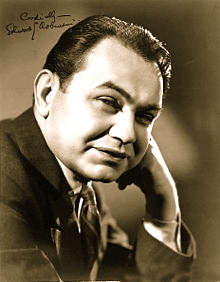Edward G. Robinson
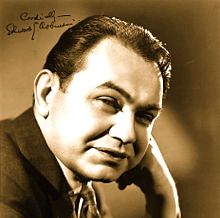
TCM Tribute to Edward G Robinson
Edward Goldenberg Robinson (Hebrew: עמנואל גאָלדנבערג Emanuel Goldenberg; December 12, 1893 – January 26, 1973) was a Romanian-born American actor. A popular star during Hollywood’s Golden Age, he is best remembered for his roles as gangsters, such as Rico in his star-making film Little Caesar and as Rocco in Key Largo.
Other memorable roles include insurance investigator Barton Keyes in the film noir Double Indemnity, Dathan (adversary of Moses) in The Ten Commandments, and his final performance as Sol Roth in the science-fiction story Soylent Green.
Robinson was selected for an Honorary Academy Award for his work in the film industry, which was posthumously awarded two months after the actor’s death in 1973. He was included at #24 in the American Film Institute’s list of the 25 greatest male stars in American cinema.
Early years and education
Robinson was born as Emanuel Goldenberg to a Yiddish-speaking Romanian Jewish family in Bucharest, the son of Sarah (née Guttman) and Morris Goldenberg, a builder.
After one of his brothers was attacked by an antisemitic mob, the family decided to immigrate to the United States. Robinson arrived in New York City on February 14, 1903. He grew up on the Lower East Side, had his Bar Mitzvah at First Roumanian-American congregation, and attended Townsend Harris High School and then the City College of New York.[citation needed] An interest in acting led to him winning an American Academy of Dramatic Arts scholarship,[citation needed] after which he changed his name to Edward G. Robinson (the G. signifying his original surname).
Career
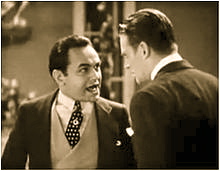 Robinson in his breakout role, Little Caesar (1931)
Robinson in his breakout role, Little Caesar (1931)
He began his acting career in the Yiddish Theater District in 1913 and made his Broadway debut in 1915.[citation needed] He made his film debut in a minor uncredited role in 1916; in 1923 he made his named debut as E. G. Robinson in The Bright Shawl. He played a snarling gangster in the 1927 Broadway police/crime drama The Racket that led to his being cast in similar film roles. One of many actors who saw his career flourish in the new sound film era rather than falter, he made only three films prior to 1930 but left his stage career that year and made 14 films between 1930–1932.
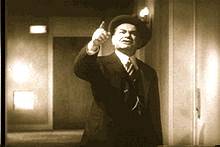 In Billy Wilder’s Double Indemnity (1944)
In Billy Wilder’s Double Indemnity (1944)
Robinson went on to make a total of 101 films in his 50-year career. An acclaimed performance as the gangster Caesar Enrico “Rico” Bandello in Little Caesar (1931) led to him being further typecast as a “tough guy” for much of his early career, in works such as Five Star Final (1931), Smart Money (1931; his only movie with James Cagney), Tiger Shark (1932), Kid Galahad (1937) with Bette Davis and Humphrey Bogart, and A Slight Case of Murder.
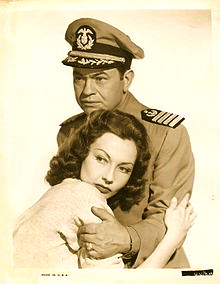 With Lynn Bari in Tampico (1944)
With Lynn Bari in Tampico (1944)
He volunteered for military service but due to age, he could not qualify during World War II. However, Robinson did become an outspoken public critic of fascism and Nazism, and donated more than US$ 250,000 to 850 political and charitable groups between 1939 and 1949. He was host to the Committee of 56 who gathered at his home on December 9, 1938, signing a “Declaration of Democratic Independence” which called for a boycott of all German-made products. He played FBI agent Turrou in Confessions of a Nazi Spy, the first American film which showed Nazism as a threat to the United States in 1939, and in 1940 played Paul Ehrlich in Dr. Ehrlich’s Magic Bullet and Paul Julius Reuter in A Dispatch from Reuter’s, both biographies of prominent Jewish public figures.
Meanwhile, throughout the 1940s Robinson also demonstrated his knack for both film noir and comedic roles, including Raoul Walsh’s Manpower (1941) with Marlene Dietrich and George Raft, Larceny, Inc. (1942) with Jane Wyman and Broderick Crawford, Billy Wilder’s Double Indemnity (1944) with Fred MacMurray and Barbara Stanwyck, Fritz Lang’s The Woman in the Window (1944) with Joan Bennett and Scarlet Street (1945) with Joan Bennett and Dan Duryea, and Orson Welles’ The Stranger (1946) with Welles and Loretta Young. He appeared for director John Huston as gangster Johnny Rocco in Key Largo (1948), the last of five films he made with Humphrey Bogart and the only one in which Bogart did not play a supporting role.
On three occasions in 1950 and 1952, he was called to testify in front of the House Un-American Activities Committee (HUAC) and was threatened with blacklisting. Robinson took steps to clear his name, such as having a representative go through his check stubs to ensure that none had been issued to subversive organizations. He did not give names of Communist sympathizers, but he repudiated the organizations he had belonged to in the 1930’s and 1940’s. His own name was cleared, but in the aftermath his career noticeably suffered, as he was offered smaller roles and those less frequently. Robinson continued his “ritual of rehabilitation by humiliation” in October 1952, when he wrote an article titled “How the Reds made a Sucker Out of Me,” that was published in the American Legion Magazine. In spite of this, he was once again called to testify before the House Un-American Activities Committee in January 1954.
His career rehabilitation received a boost in 1954, when noted anti-communist director Cecil B. DeMille cast him as the traitorous Dathan in The Ten Commandments. The film was released in 1956, as was the psychological thriller Nightmare. After a subsequent short absence from the screen, Robinson’s film career—augmented by an increasing number of television roles—restarted for good in 1958/59, when he was second-billed after Frank Sinatra in the 1959 release A Hole in the Head. The last-ever scene Robinson filmed was a euthanasia sequence in the science fiction cult film Soylent Green (1973); it is sometimes claimed that he told friend and co-star Charlton Heston that he, Robinson, had in fact only weeks to live at best. As it turned out, Robinson died only twelve days later.
Personal Life
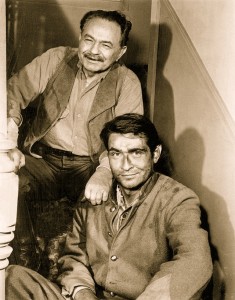 Robinson and his son in a 1962 episode of Dick Powell’s Zane Grey Theatre.
Robinson and his son in a 1962 episode of Dick Powell’s Zane Grey Theatre.
Robinson married his first wife, stage actress Gladys Lloyd, in 1927, born Gladys Lloyd Cassell; she was the former wife of Ralph L. Vestervelt and the daughter of Clement C. Cassell, an architect, sculptor and artist. The couple had one son, Edward G. Robinson, Jr. (a.k.a. Manny Robinson, 1933–1974), as well as a daughter from Gladys Robinson’s first marriage. In 1956 he was divorced from his wife. In 1958 he married 38-year-old Jane Bodenheimer, a dress designer known as Jane Arden.
In noticeable contrast to many of his onscreen characters, Robinson was a sensitive, softly-spoken and cultured man, who spoke seven languages. Remaining a liberal Democrat despite his difficulties with HUAC, he attended the 1960 Democratic Convention in Los Angeles, California. He was a passionate art collector, eventually building up a significant collection and partnering with Vincent Price to run a gallery. In 1956, however, he sold his collection to Greek shipping tycoon Stavros Niarchos to raise cash for his divorce settlement with Gladys Robinson; his finances had suffered due to underemployment in the early 1950s. Another of his chief pastimes was collecting records of the world’s leading concerts.
Robinson died of bladder cancer in 1973, and is buried in a crypt in the family mausoleum at Beth-El Cemetery in the Ridgewood area of the borough of Queens in New York City.

